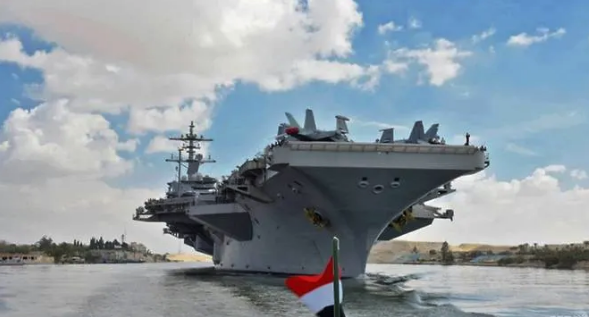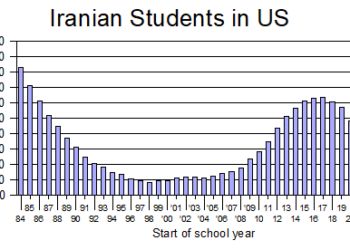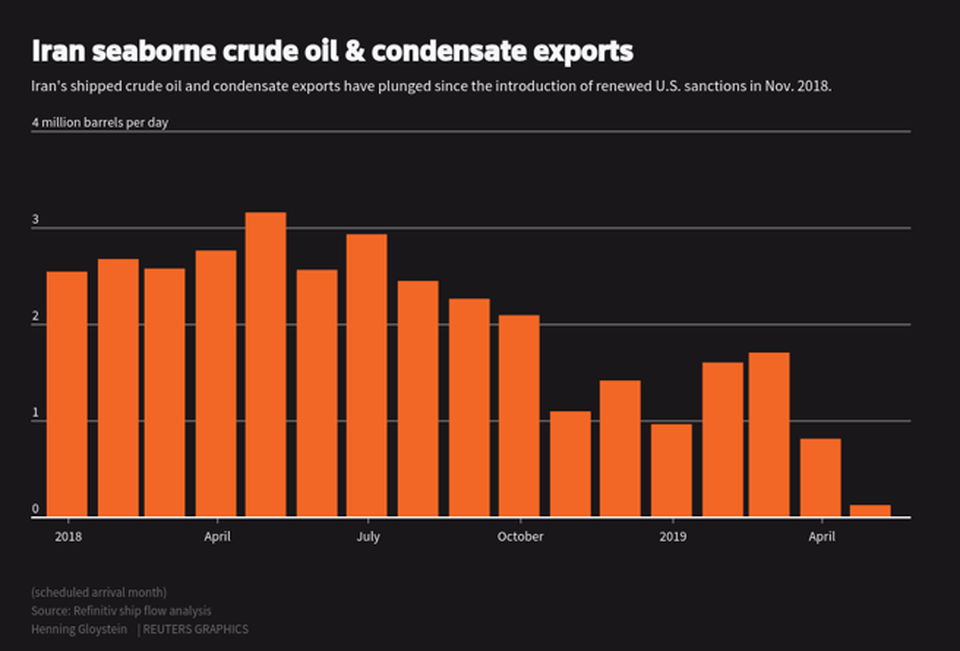May 17, 2019
by Warren L. Nelson

As part of its “maximum pressure” policy on Iran, the White House announced May 5 that it was sending the aircraft carrier Abraham Lincoln and a bomber task force to the Middle East “to send a clear and unmistakable message to the Iranian regime.”
The action was taken after US intelligence intercepted word that Iran had told its proxies across the Middle East that they were now free to attack American troops whenever they wished.
The actual “pressure” appeared to come mainly from the dramatic two-sentence White House announcement itself. Sending an aircraft carrier and bombers to the Persian Gulf is nothing new. Until recently, the US Navy had kept one carrier in the region all the time. And a carrier and some B-1 bombers were in the region as recently as last month.
Later, the Pentagon announced it was also sending one battery of Patriot anti-aircraft missiles to the region. It did not mention that just a few months ago it removed four Patriot batteries from the region.
The “bomber task force” comprised just four B-52 bombers, which are normally used to dump a massive load of bombs over a wide area in order to eliminate an entire enemy ground unit. The B-52 carries the largest bomb load of any American combat aircraft.
The written White House announcement, issued over the name of National Security Advisor John Bolton, said the deployments were in response “to a number of troubling and escalatory indications and warnings…. Any attack on US interests or on those of our allies will be met with unrelenting force.”
The fact that the announcement came over the name of Bolton—known as the hardest of the hardliners in the Trump Administration—brought extra focus to the deployment. Some wondered why Trump himself didn’t issue the announcement. He usually likes to announce tough policies, but chose to stand in the background of this one for some reason.
A few days passed with no explanation of the “troubling and escalatory indications.” Then some officials in the Pentagon told reporters Iran had been seen practicing for attacks on American forces. But that is nothing new. It has been going on for decades. Just two years ago, the Iranian Navy built a wooden mockup of a US aircraft carrier and then attacked it—but was unable to sink it. No news reports cited any specific training program as hostile as practicing to attack an aircraft carrier.
Finally, various officials said US intelligence had intercepted a message saying that an Iranian official had been found telling Iran’s proxies in Iraq that they were now free to attack American troops. This was first reported by NBC News four days after the White House announcement, but was later reported by many other news outlets.
For the last few years, while Iran and the United States were “united” in fighting the Islamic State, Iran has restrained its proxies. But before that, Iran made war on the US through Iraqi militias. The Pentagon recently said that Iranian-supplied “explosively-formed penetrators” (EFP), used by militias in Iraq, had killed 603 US troops before that restraint was imposed.
Other intelligence reported that Iran had loaded missiles on at least one dhow. These might be continuing shipments to the Houthi rebels in Yemen. But some in the Navy feared Iran might use the missiles to attack US Navy ships in the region because Iran had previously sent disassembled missiles to the Houthis, while the missiles seen being loaded on the dhow were assembled and ready for use.
The Iranian military has long owned about 70 small missile-equipped attack boats. The significance of loading missiles on a dhow is that it suggested Iran was preparing an attack disguised as coming from some rebel group in the Middle East with Iran denying involvement.
Trump has long complained about US involvement in the Middle East, focusing on its cost in lives and capital, and has even ordered troop withdrawals from Afghanistan and Syria before the State Department, Pentagon and CIA convinced him to reverse himself. The announcement of the latest deployment may not have been made by Trump because he does not like being identified with deeper involvement in warfare in the Middle East.
Most of the attention focused on the “dramatic” order sending the USS Abraham Lincoln to the Middle East. But Pentagon officials later admitted the carrier was slated to head to the Persian Gulf in just a matter of weeks anyhow and the White House announcement only meant the sailing was being speeded up. The Lincoln was already in the Mediterranean and on May 9 sailed through the Suez Canal, two weeks earlier than originally planned, accompanied by a cruiser and four destroyers.
The White House statement did not threaten any military action. In fact, it did the opposite. It said, “The United States is not seeking war with the Iranian regime, but we are fully prepared to respond to any attack, whether by proxy, the Islamic Revolutionary Guard Corps, or regular Iranian forces.” In other words, it was saying the US might use force against Iran only if its proxies attacked US troops.
Iran responded by playing down the US announcement. While the Islamic Republic likes to take a tough line with the United States, it has long wanted to avoid even the hint that it might go to war with the Americans. Many Iranians complain that the regime is provoking a war with its vocal hostility against the United States and fear the Islamic Republic will cause a war. So, whenever Washington starts talking more harshly, Tehran retreats.
The Pasdaran didn’t get the word, however. Gen. Amirali Hajizadeh, chief of the Pasdar aerospace branch, which includes its missile force, talked tough. “An aircraft carrier with 40 to 50 planes on it and 6,000 sailors was a serious threat in the past, but now it is a target. The threats have switched to opportunities. If they make a move, we will hit them in the head.”
The Supreme National Security Council was more measured, issuing a statement saying the White House announcement was merely “psychological warfare.”
That was basically accurate. The US was not sending the carrier and bombers to the Middle East to attack Iran but rather to try to induce the Islamic Republic to reverse its policy on authorizing proxies to kill American troops.
The day after the White House announcement Adm. John Richardson, the head of the US Navy, told a gathering that the deployment of the Lincoln to the Middle East had been planned “for some time now.”
The United States said the carrier was being assigned to the “Central Command,” which includes a large part of the Indian Ocean as well as the Persian Gulf and the Red Sea. (See accompanying map at left.) It did not say whether the carrier would enter the Persian Gulf, though carriers usually do so for part of their deployments to the region.
The bombers were sent to Udaid Air Base in Qatar, which is the largest US air base in the region. Bombers are routinely deployed on and off to the region, and B-1 bombers were there as recently as last month.
Iran, which has grown closer to Qatar since it has fallen out with Saudi Arabia and the UAE, may not be happy about that and likely urged the Qataris to refuse to allow the bombers there. Iran announced that President Rohani had telephoned the Qatari emir after the White House announcement, but said nothing about the content of the call.
The fact that Qatar rebuffed Iran and accepted the bombers may be the most worrisome development for Iran. Qatar was cast aside two years ago by Saudi Arabia and the UAE for not hewing to their line. That forced Qatar to move closer to Iran. Qatar now gets much of its food imports through Iran; planes coming to its airport must fly over Iran because Saudi Arabia and the UAE won’t allow them to use their airspace anymore. The fact that Qatar accepted the B-52 deployment tells Iran very clearly that to Qatar it ranks below the United States in importance.
The B-52 is the largest combat aircraft in the US inventory. It is powered by eight jet engines.
Until last year, the United States had a policy for many years of keeping at least one aircraft carrier in the Central Command region at all times. But in March of last year, it did not replace the carrier that left the region that month. In the 14 months since then, it has assigned one carrier to the region for a few months only. It left the region just a few weeks ago.
The US media filled itself with stories about a potential war, some saying Trump was angling for a war and that was why he sent such a huge force to the region, although it wasn’t a huge force. Others said Trump was ignorant about foreign policy and would stumble into a war even though he didn’t want one.
The New York Times reported that Bolton had talked with the Pentagon about possibly sending 120,000 troops to the region. It turned out the Pentagon sent such a plan to Bolton because Bolton requested it. But Trump rejected it. In fact, aides said Trump had told Bolton and others to calm down. “He doesn’t want to go to war,” one told Reuters.
CNN said Trump was angry at Bolton and others for beating war drums. He emphasized that what he seeks from Iran is talks for a new agreement to replace the Joint Comprehensive Plan of Action (JCPOA).
Then Reuters reported that the British officer who is the deputy commander of Western forces in Iraq said he didn’t see a mounting threat from “any “ of the militias in Iraq. Two days later, Reuters sent out a correction. Major General Chris Ghika had said he didn’t see a mounting threat from “many” of the militias in Iraq.



















